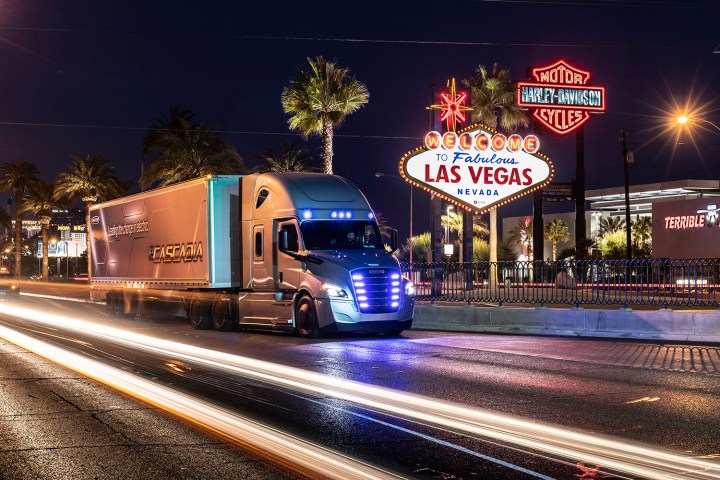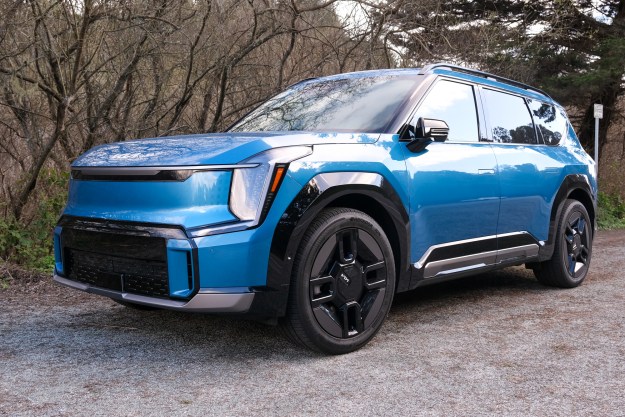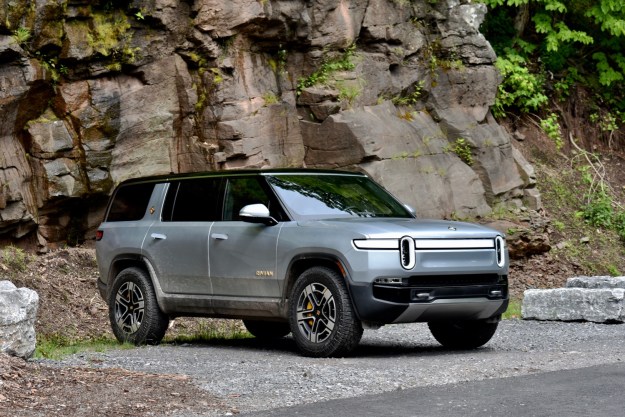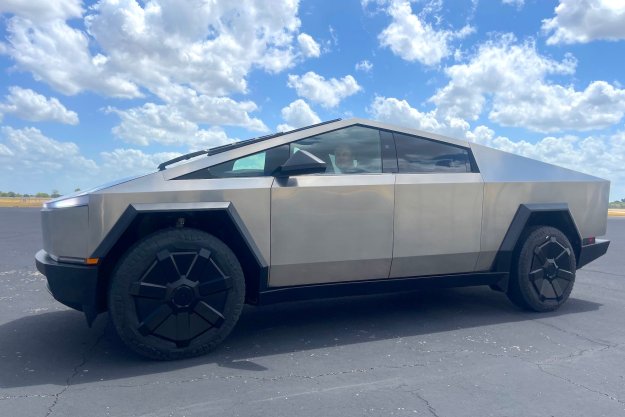
“Go slow.” Yeah, you don’t have to tell me twice. It’s the first time I’ve ever driven a full-blown, road-hogging, fully loaded (78,000 pounds!) tractor trailer. Of course, I’m going to take it easy.
Why is Daimler letting me take a massive vehicle out for a spin, during 2019 CES? I don’t have a Class B commercial trucker’s license, and while I’ve driven everything from a Lamborghini Huracán to a Rolls-Royce Wraith, I’ve got no experience with big rigs.
Because this tractor trailer is electric. And I’m driving it on a closed Las Vegas track. And it’s actually really cool.
The eCascadia is based on the diesel Cascadia from Daimler’s Freightliner division, a Class 8 18-wheeler and one of the most popular long-haul trucks currently on the road in North America. By allowing me to take it for a spin, Daimler is making a bold statement that it is out in front (way out in front) of much hyped upstarts like Tesla and Thor. The eCascadia is real, drives like a charm, and is about to undergo actual testing in the U.S. on public roads as Daimler delivers 20 of the vehicles to Penske. With professional truckers behind the wheel running regular routes, Daimler hopes to learn more about how the vehicles handle, endure the rigors of the road, deal with charging and route issues, and manage other factors that can’t be accounted for until these trucks are used in the real world.
Daimler is making a bold statement that it is out in front of much hyped upstarts like Tesla and Thor.
While battery powered sedans aren’t so radically different to drive than traditional cars, the electric truck is a major departure from a diesel-powered, boisterous big rig. Gone is the lurching and stomach-churning up- and down-shifting of a big diesel truck. The electric model is balanced and poised. That means it’s easier to drive and, by extension, it should be safer to operate.
Also eliminated are the noise pollution of the incessant roar of traditional tractor trailers, not just the particulates and smog. The electric power is nearly noiseless and made even quieter thanks to the addition of aerodynamic fairings and air dams. Even the latest Cascadia driver assistance technologies like lane keeping and adaptive cruise control, available only on the diesel version, are no match for the eCascadia in terms of ride comfort and drivability. The eCascadia accelerates smoothly and glides to a virtually silent stop. I had no trouble taking the truck around a course and yet, also never felt I wasn’t always in control (I only took it up to about 50 miles per hour).
There are some things that had to be adjusted on the eCascadia to account for the electric power. To prevent drivers from tearing up the tires, for example, Daimler had to put torque limiting on the vehicle to keep the low-end power that electric motors provide from being abused. There’s still plenty of power to merge the rig onto a highway, but not so much that you’re tempted to drag race the 18-wheeler on city streets.

Of course, the eCascadia is still a tractor trailer, which becomes immediately apparent when a neophyte like me gets behind the wheel. The flatter steering wheel placement — necessary on trucks so that the wheel doesn’t bang against the driver’s knees — and the massive blind spots are initially intimidating. I kept checking to make sure my turns were wide enough for the trailer to clear the cones on the track. And the hushed electric power can be deceptive: You’ve still got tons of weight behind you, meaning that stopping distances are agonizingly long.
Gone is the lurching and stomach-churning shifting of a big diesel truck. The electric model is balanced and poised.
The eCascadia has four electric motors (two on each axle) and can deliver up to 730 horsepower. With 550-kilowatt-hour batteries, the truck has a rated range of 250 miles. Daimler says it could be recharged to about 80 percent of full power in 90 minutes (giving it a 200-mile range). The truck does not, unfortunately, have some of the systems developed on the company’s autonomous rig. There are no video systems in the front A-pillars, for example, to eliminate rear-view blindspots, and it doesn’t possess the kind of semi-autonomous highway autopilot systems Daimler has been testing in Nevada. Still, it’s easy to see how those systems could be incorporated, making a professional trucker’s life much easier and safer.
That is definitely one of the goals, according to the CEO of Daimler Trucks North America, Roger Nielsen. So the company has been assessing and reassessing technologies, with plans to invest about half-a-billion dollars into putting autonomous semi-autonomous systems into commercial trucks. One feature that is unlikely to make it to U.S. roads, however, Nielsen said, is the idea of platooning, in which several trucks would follow each other in a tight line, led by a single vehicle.
“It’s too difficult to get the fuel savings,” Nielsen explained. Ideal conditions have to be created for platooning to work. No one can cut in front of any of the trucks; the exact weight of all the trucks has to be measured so that the heavier trucks (those that take longer to stop) are in front; and when a truck leaves the platoon the other vehicles have to close the gap quickly.
“Furthermore, it makes the follow driver’s life more stressful,” Nielsen said. Anyone who’s been stuck staring at the rear end of a tractor trailer for miles on end can understand the problem.
Daimler has plans to invest about half-a-billion dollars into putting autonomous systems into commercial trucks.
The trucking technology that has been working, Nielsen said, is the semi-autonomous braking assistance systems being used in Europe. And lane-keeping-assist systems show a lot of promise, making it easier for drivers to control trucks that can behave like big sails when there’s a strong cross wind. While it’s too early to cull statistics that reflect such the safety improvements, “we see it in our bumper sales and hood sales,” Nielsen said. In other words, fewer parts sold mean there are fewer accidents.
Inevitably and predictably, people are going to ask how the Daimler eCascadia compares to the Tesla Semi. Tesla made a big splash in 2017 announcing its plans to make a big rig and taking pre-orders from the likes of Walmart. At the time, Tesla said its tractor trailers would have a heretofore unheard of 500-mile range. But nearly two years later, the Tesla Semi has yet to appear. It’s now slated to make an appearance next year.
Skeptics will inevitably try to throw cold water on Elon Musk’s truck, but it should be pointed out that the Tesla Semi program is led by Jerome Guillen, a former Daimler executive. Furthermore, despite all the criticism about slipped delivery dates and quality control problems, Tesla has undeniably done more to promote and encourage the electric vehicle revolution than any other single company. So don’t count it out of the truck race just yet. But for now, the spotlight is on Daimler.


